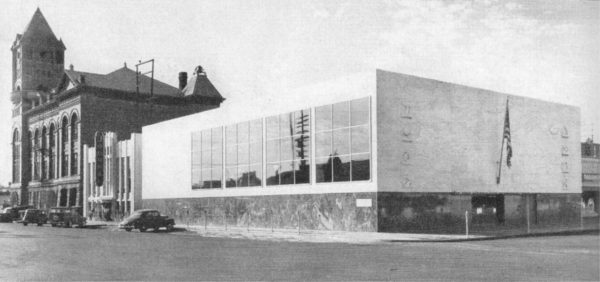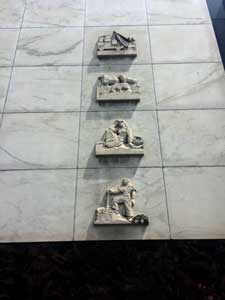One of Pietro Belluschi’s landmarks faces demolition in downtown Salem.
Despite its listing in the National Register of Historic Places, Pietro Belluschi’s First National Bank of Salem building will likely be demolished by September 6th.
Constructed in 1946, the building’s design follows a mid-career trend in the work of Oregon’s foremost modernist and features the exquisite application of pink and grey granite at the lower level of both of its primary elevations with white marble panels above. The rather severe façade of the building is broken by a slightly recessed entry surmounted by an angled flag pole and eight beautifully-executed marble reliefs by Frederic Littman on the theme of Oregon industry. The side of the building is devoid of ornamentation but exhibits a large display of steel sash windows across its upper expanse. Similar materials and detailing can be found in Portland’s 1948 Oregonian Building and as far away as Boise in the Idaho Statesman Building of 1952.

Despite having been occupied by various banks for half a century, the building has been unoccupied since approximately 2000. In 2001, the bank was listed in the National Register as a contributing element of the Salem Downtown State Street-Commercial Street Historic District. While listed properties in Salem enjoy the protection of design review and the possibility of demolition denial by the city’s Historic Landmarks Commission, owners of listed sites may apply to the commission for approval to alter or demolish historic structures. In 2008, the long-time owners of the First National Bank building successfully applied to the Salem Historic Landmarks Commission for permission to demolish the structure and construct a new mixed-use development in its place.
As part of the demolition approval, the commission applied three conditions which must be met by the owner. The first, a thorough documentation of the building which meets Historic American Building Survey (HABS) standards has already been completed. The second stipulation is the development and installation of interpretive signage at the site describing the architectural and historical importance of the building while the third is the careful removal, storage and reuse of the Littman sculptural reliefs on the exterior of the building. Neither have yet been accomplished.

With development plans hampered by the national downturn in the economy, the ownership group was successful in receiving three subsequent two-year extensions. The last of those extensions will expire in early September and the owners must begin demolition or re-apply for a new land use approval with no guarantees of receiving permission to demolish the building.
Restore Oregon has recently learned that the property is in the process of being sold. The new buyer has not yet been identified. We share concerns with the community that the loss of this modernist landmark will irreparably damage the fabric of Salem and its Downtown State Street-Commercial Street Historic District. Furthermore, because of the national importance of Belluschi and his work, this demolition and its impact would be felt across the Pacific Northwest and beyond.
Restore Oregon continues to monitor and assess the situation. Please contact us if you see any changes at the site.


Having lived in Salem twice, both as a grade-schooler and again as an adult, I have fond memories of this building. The marble always gleamed and it was a bright spot on any drive through town.
I am shocked to learn that it has been vacant for 15 years — and am very sad to hear that it might be razed, and I’m astounded that no one has found a suitable alternate use for it. What is the status of the interior?
Since the building is part of the Salem Downtown State Street-Commercial Street Historic District (see its National Register application [http://npgallery.nps.gov/pdfhost/docs/NRHP/Text/01001067.pdf]), demolition of it and construction of a new, mixed-up building on the site would appear to violate the integrity of the District. As described in the application, the “Salem Downtown Historic District is an architecturally and historically cohesive district memorializing the development of Salem, Oregon’s, downtown historic commercial core. The district’s period of significance extends from 1867/1868, the date of the oldest extant building, to around 1950, when the exterior remodeling of a number of buildings had been completed and one building/structure was constructed. Historic resources in the district built during the period of significance convey cyclical eras of both robust growth (notably the 1870s-1880s, 1902-1920s, and 1945-1950), and slack development (the 1890s and 1930s) in the community.”
At the time of the District’s Historic Register application, there were 57 buildings within it considered to be Contributing (in addition to those 38 percent that were considered NonContributing, there were 16 vacant lots occupied by parking lots). Although this building — one out of 57 — represents only a small percentage of the District, it is nevertheless the only building constructed after the 1920s.
The description of the building in the District’s Historic Register application, states, in relevant part:
“This modern building was designed by renowned Portland architect, Pietro Belluschi. Constructed of
reinforced concrete, the building is sheathed with granite and marble; the interior includes birch paneling and a unique ceiling tile pattern. The plan as described in Progressive Architecture (February 1949) was to site the building on a prominent corner in Oregon’s capital city, with the front toward the west, the long side along the north, in a U-shaped plan scheme, with entrance doors on center; a mezzanine work space above rear of main floor; a basement area for safety-deposit-box customers, vaults, storage, employee cafeteria and mechanical rooms. The exterior wall surface of granite at the base and marble above, were applied as thin slabs as a veneer that was emphasized by the alignment of the joints. The sculptures on the west elevation were done by Frederick Littman.
“This building is significant for its association with Pietro Belluschi, and as an excellent example of the Modern style in Salem. *** [Belluschi’s] program for the First National Bank was to have it serve not only as an efficient banking institution, but that it reflect some of the solidity and reliability of the parent organization in Portland. The building has continued to be used for banking purposes and [at the time] house[d] the Wells-Fargo Bank.
“Several buildings designed or remodeled in the Modern period throughout the district clearly convey the impact of the national post-World War II boom in building construction on developmental changes in Salem’s commercial core. Several buildings in the district underwent substantial exterior remodeling on the main facade during the 1940s. Although varied in style, buildings in the Salem Downtown Historic District share similar proportions and classical design elements that give the district an overall visual
cohesion.”
There’s an interesting forum discussion of the building at https://bonniehull.net/2011/05/10/salem-buildings, with some great photos and commentators being both for and against it, and offering suggestions for alternate uses (none of which I personally support).
I hope that efforts to save this wonderful building are successful. We seem to be all too ready these days to demolish the past, which is a loss to everyone.